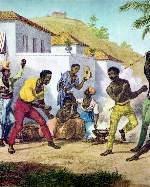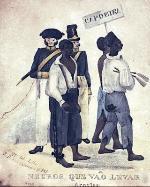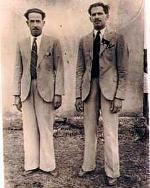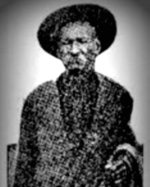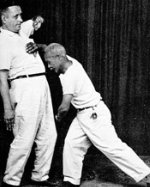The Roots of Capoeira
Talk the Talk
A Capoeira player is also called a Capoeirista and an expert in the art is referred to by the title Mestre, which is Portuguese for Master.
Walk the Walk
Being caught practicing a martial art would be unthinkable for slaves as they would face unspeakable tortures if they were.
However this did not stop the early pioneers of capoeira, who hid the fighting techniques within dance moves so as not to be discovered by any authority figure that might be watching.
However this did not stop the early pioneers of capoeira, who hid the fighting techniques within dance moves so as not to be discovered by any authority figure that might be watching.
Capoeira Quote
"Well, there is one thing that no one doubts: it was the Africans from Angola who taught us capoeira.
It’s possible that it used to be very different from the capoeira of today. They tell me that there are written records proving this. I believe it".
~ Mestre Pastinha ~
It’s possible that it used to be very different from the capoeira of today. They tell me that there are written records proving this. I believe it".
~ Mestre Pastinha ~
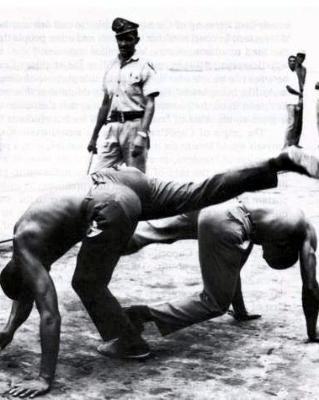 The Capoeira fighter is an athlete who is capable of executing almost gymnastic-like techniques that are reminiscent of a dance. However, like all of the best martial arts systems, it should not be underestimated as it can be a powerful form of combat that has been developed and refined into a deadly fighting style that is unique within martial arts history.
The Capoeira fighter is an athlete who is capable of executing almost gymnastic-like techniques that are reminiscent of a dance. However, like all of the best martial arts systems, it should not be underestimated as it can be a powerful form of combat that has been developed and refined into a deadly fighting style that is unique within martial arts history.
The full details of capoeira history are unknown and have gone largely unstudied by academics. It is known that it was started by African slaves who brought the fighting and dancing techniques of capoeira to Brazil when they were taken there by the Portuguese Conquistadors. However, it is unclear whether these techniques came across as an already formed fighting system, or were put together by slaves wishing to learn martial arts.
Capoeira History in Africa
One possibility is that capoeira history is older than the arrival of the slaves in Brazil and had already been developed in Africa by the time they got there. It could be that it was already a part of the culture from one of a number of possible African regions and was brought over with the slaves that began arriving in around 1500 CE.According to Portuguese scholar Albano de Neves e Souza: "Among the Mucupe in Southern Angola, there is a zebra dance, the n’golo ... The n'golo is capoeira." Brazil as the birthplace for capoeira is also brought into question by African scholar Dr K. Kia Bunseki Fu-Kia, who believes it has its origins in the Congo. He stated in 1993: "Kipura, in the Congo cultural context, is ... an individual whose techniques of fight or struggle are based or developed on the ground of rooster's fighting techniques."
The History of Capoeira - Brazil
The fact that the capoeira fighter sprang up in different parts of Brazil around the time the slaves arrived with apparently no connection between captives in different regions seems to support the African roots theory. However, a more popular view is that the martial art began in Brazil. Professor of Journalism Augusto Ferreira believes capoeira moves were first developed as fighting techniques by runaway slaves in order to defend themselves. Tens of thousands of them escaped forming thousands of hidden societies known as quilombos (settlements) and this, according to Ferreira, was where capoeira was developed.
Alternatively, some believe the history of fighting in the capoeira style came from urban areas of Brazil and was originally a game played by slaves at market. Prominent Brazilian linguist Antenor Nascentes believes that slaves carrying baskets of chickens on their heads formed the game as the word they used for the basket was capoeiras. Nascentes stated, "The slaves ... would enjoy themselves by playing the game of capoeira. As a metonymy res pro persona, the name of the thing was passed on to the person related with it."
Alternatively, some believe the history of fighting in the capoeira style came from urban areas of Brazil and was originally a game played by slaves at market. Prominent Brazilian linguist Antenor Nascentes believes that slaves carrying baskets of chickens on their heads formed the game as the word they used for the basket was capoeiras. Nascentes stated, "The slaves ... would enjoy themselves by playing the game of capoeira. As a metonymy res pro persona, the name of the thing was passed on to the person related with it."
Conclusion
The exact history of the martial arts form known as capoeira may never be known for sure. It may have arrived from Africa with the slaves and be a combination of some of the best martial arts from the continent, or it may have originated as an art form in Brazil. What can be determined is that it is heavily influenced by African cultures. What’s more, it has adapted to the needs of the people who have used it down the centuries and continues to do so. As the great Mestre Pastinha once said, "capoeira is capoeira, is capoeira, is capoeira."
Capoeira History. [Internet]. 2012. Rensselaer Polytechnic Institute. Available from: http://capoeira.union.rpi.edu/history.php [Accessed 13 November, 2012].
What is Capoeira? [Internet]. 2012. Princeton University. Available from: http://www.princeton.edu/~capoeira/ln_abt.html [Accessed 13 November, 2012].
Quotes from Mestre Pastinha. [Internet]. 2011. Capoeira Connection. Available from: http://capoeira-connection.com/capoeira/2011/10/quotes-from-mestre-pastinha-1967/ [Accessed 24 November, 2012].
Written by Andrew Griffiths – Last updated 24/10/2023. If you like
what you see, consider following the History of Fighting on social media.
Further Reading:
Capoeira - An Introductory History. [Internet]. 1996. The Latin American Institute. Available from: http://www.capoeira.bz/mestreacordeon/capoeira/history.html [Accessed 13 November, 2012].Capoeira History. [Internet]. 2012. Rensselaer Polytechnic Institute. Available from: http://capoeira.union.rpi.edu/history.php [Accessed 13 November, 2012].
Maroon People. [Internet]. 2012. National Geographic. Available from: http://ngm.nationalgeographic.com/2012/04/maroon-people/mann-hecht-text [Accessed 13 November, 2012].
What is Capoeira? [Internet]. 2012. Princeton University. Available from: http://www.princeton.edu/~capoeira/ln_abt.html [Accessed 13 November, 2012].
Quotes from Mestre Pastinha. [Internet]. 2011. Capoeira Connection. Available from: http://capoeira-connection.com/capoeira/2011/10/quotes-from-mestre-pastinha-1967/ [Accessed 24 November, 2012].
More Capoeira History
Capoeira History Home
An overview of the history of capoeira from its early roots, its development by slaves in Brazil, how it flourished amongst criminals and its further development and legitimisation by Mestre Bimba in the early twentieth century.
An overview of the history of capoeira from its early roots, its development by slaves in Brazil, how it flourished amongst criminals and its further development and legitimisation by Mestre Bimba in the early twentieth century.
Brazil’s Criminal Underworld
From the late 19th century, the criminal underworld of Brazil saw its numbers dramatically rise when slavery legally came to an end in 1888. Many skilled fighters became powerful and as many of them were capoeirista, the martial art became synonymous with criminal gangs.
From the late 19th century, the criminal underworld of Brazil saw its numbers dramatically rise when slavery legally came to an end in 1888. Many skilled fighters became powerful and as many of them were capoeirista, the martial art became synonymous with criminal gangs.
Mestre Manduca da Praia – The Elegant Capoeira Fighter
Mestre Manduca da Praia, known as ‘The Elegant Capoeira Fighter’ was a nineteenth century Brazilian martial artist who was not only a ferocious warrior, but managed to maintain his standing as a respectable business man with in his community.
Mestre Manduca da Praia, known as ‘The Elegant Capoeira Fighter’ was a nineteenth century Brazilian martial artist who was not only a ferocious warrior, but managed to maintain his standing as a respectable business man with in his community.
Jose Antonio do Nascimento
Jose Antonio do Nascimento was one of the best fighters of the nineteenth century. His skills earned him a fearsome reputation and his size and prowess earned him the nickname Nascimento Grande (Big Birth).
Jose Antonio do Nascimento was one of the best fighters of the nineteenth century. His skills earned him a fearsome reputation and his size and prowess earned him the nickname Nascimento Grande (Big Birth).
Mestre Besouro Manganga
Besouro Manganga was such a prolific capoeira fighter that people believed him to have magical powers (known as corpo fechado). His agility and nimbleness helped him avoid capture time and time again, and even when cornered by police, he would usually come out on top.
Besouro Manganga was such a prolific capoeira fighter that people believed him to have magical powers (known as corpo fechado). His agility and nimbleness helped him avoid capture time and time again, and even when cornered by police, he would usually come out on top.
Mestre Bimba
Mestre Bimba is important in capoeira history because of the role he played in legitimizing the art. By introducing a code of ethics, set training methods and a number of new techniques, he helped change capoeira from an illegal discipline associated with crime, to an iconic cultural pastime.
Mestre Bimba is important in capoeira history because of the role he played in legitimizing the art. By introducing a code of ethics, set training methods and a number of new techniques, he helped change capoeira from an illegal discipline associated with crime, to an iconic cultural pastime.
Angola Capoeira
The Angola style of capoeira is one of the two main systems of the art and was introduced in 1942 by Mestre Pastinha. Unlike the other style, Regional capoeira, it focuses the individual development of each capoeirista as opposed to practicing set sequences and training methods and is more akin to the type of capoeira practiced prior to the 20th century.
The Angola style of capoeira is one of the two main systems of the art and was introduced in 1942 by Mestre Pastinha. Unlike the other style, Regional capoeira, it focuses the individual development of each capoeirista as opposed to practicing set sequences and training methods and is more akin to the type of capoeira practiced prior to the 20th century.
The images on this site are believed to be in the public domain, however, if any mistakes have been made and your copyright or intellectual rights have been breeched, please contact andrew@articlesonhistory.com.


